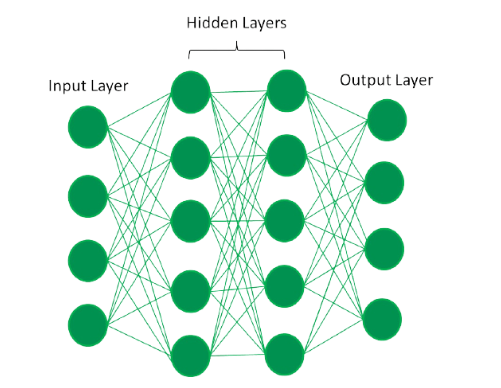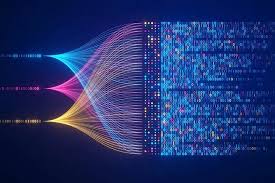Deep learning, a branch of machine learning, employs multilayered neural networks—known as deep neural networks—to mimic the complex decision-making abilities of the human brain. It powers many of today’s AI applications.
As a core component of artificial intelligence, deep learning drives various AI services and models. Large language models like ChatGPT, Bard, and Bing Chat, as well as image generators like Midjourney and DALL-E, use deep learning to understand language, context, and generate realistic outputs. Predictive AI models also rely on deep learning to draw insights from vast amounts of historical data.
How does deep learning work?
Neural networks, or artificial neural networks, simulate the human brain using data inputs, weights, and biases that function like silicon neurons. These components work together to recognize, classify, and describe data accurately.
Deep neural networks have multiple layers of interconnected nodes, with each layer building upon the previous one to improve predictions or classifications. This flow of information through the network is called forward propagation. The first and last layers are the visible layers: the input layer receives data, and the output layer produces the final prediction or classification.
Backpropagation is another process that uses algorithms like gradient descent to measure prediction errors and adjust weights and biases by moving backward through the layers. Together, forward propagation and backpropagation allow the network to make predictions and learn from mistakes, gradually increasing accuracy over time.

Deep learning demands significant computing power. High-performance GPUs are ideal as they can perform many calculations simultaneously across multiple cores while offering ample memory. Distributed cloud computing can also help meet these needs. Such computing resources are essential for training deep learning models. However, managing multiple on-premises GPUs can strain internal resources and become very expensive to scale. On the software side, most deep learning applications are developed using frameworks like JAX, PyTorch, or TensorFlow.
Types of deep learning models
There are several common types of deep learning models, including:
- Feedforward neural networks (FNNs) are the simplest type of ANN, where data flows in one direction from input to output. It is used for basic tasks like classification.
- Convolutional Neural Networks (CNNs): Primarily used for image recognition, CNNs excel at detecting objects in images, even when partially hidden or distorted.
- Recurrent Neural Networks (RNNs): Used in natural language processing and speech recognition, RNNs effectively understand context in sentences and can generate text or translate languages.
Deep Learning Applications
1. Computer vision
In computer vision, deep learning models help machines recognize and interpret visual information. Key applications include:
- Object detection and recognition: These models locate and identify objects in images and videos, enabling technologies like self-driving cars, surveillance systems, and robotics.
- Image classification: Deep learning can categorize images into groups such as animals, plants, or buildings, which is useful in fields like medical imaging, quality control, and image search.
- Image segmentation: Models can divide images into distinct regions, allowing identification of specific features within the visuals.
2. Natural language processing (NLP)
In natural language processing (NLP), deep learning models enable machines to comprehend and generate human language. Key applications of deep learning in NLP include:
- Automatic text generation: These models learn from large text corpora and can automatically produce new content such as summaries or essays.
- Language translation: Deep learning enables translation between languages, facilitating communication across different linguistic backgrounds.
- Sentiment analysis: Models can assess the sentiment expressed in text, identifying whether it is positive, negative, or neutral.
- Speech recognition: Deep learning powers the transcription of spoken words, enabling applications like speech-to-text, voice search, and voice-activated devices.
3. Reinforcement learning
In reinforcement learning, deep learning is used to train agents to make decisions within an environment to maximize rewards. Key applications of deep learning in this area include:
- Game playing: Deep reinforcement learning models have outperformed human experts in games like Go, Chess, and Atari.
- Robotics: These models help train robots to handle complex tasks such as object grasping, navigation, and manipulation.
- Control systems: Deep reinforcement learning can manage complex systems, including power grids, traffic flow, and supply chain optimization.
4. Generative AI
Generative AI, or gen AI, is a type of AI that automatically creates text, images, videos, data, or other content based on user prompts. It uses deep learning models to learn from existing patterns and generate similar new content. Widely used in areas like customer service, marketing, software development, and research, generative AI has great potential to speed up enterprise workflows through fast, automated content creation.
Generative AI works well with diverse unstructured data—such as emails, images, videos, audio, and social media—which supports model training and ongoing improvement. This data helps enhance services like chatbots and efficient email routing by guiding users to the right resources or agents.
Despite its challenges and risks, many companies are cautiously adopting generative AI to boost workflow efficiency and improve products, aiming to balance innovation with legal and ethical considerations.
5. AI agents and agentic AI
An AI agent is an autonomous program that performs tasks and achieves goals without human intervention by designing its own workflows and using available tools. Agentic AI is a system of multiple agents working together to handle more complex tasks. Unlike chatbots, AI agents act independently, with clear goals and adaptability. They represent the next step beyond generative AI by not only creating content but also coordinating actions with other tools to make decisions and complete tasks. For example, an AI agent can not only advise on the best time to climb Mt. Everest but also book flights and hotels for you.
Conclusion
In conclusion, deep learning stands at the forefront of technological innovation, reshaping the landscape of artificial intelligence. As we navigate through the definitions, significance, and various neural network types, it becomes evident that deep learning is not merely a technological advancement; it's a paradigm shift in how we approach and solve complex problems.
With its continued evolution, deep learning promises a future where machines not only assist but truly understand and adapt to the complexities of the world around us.

